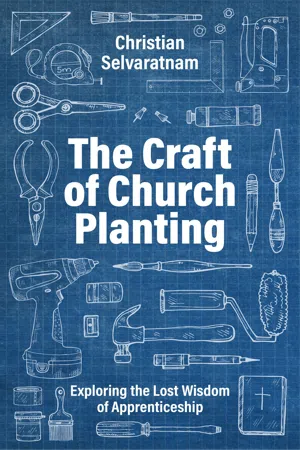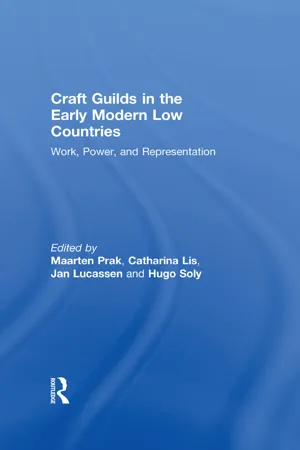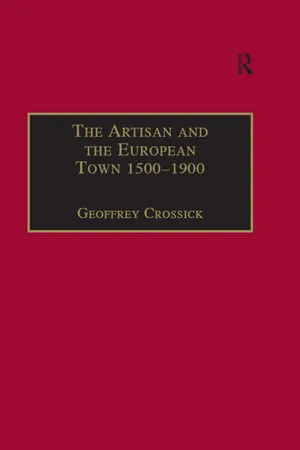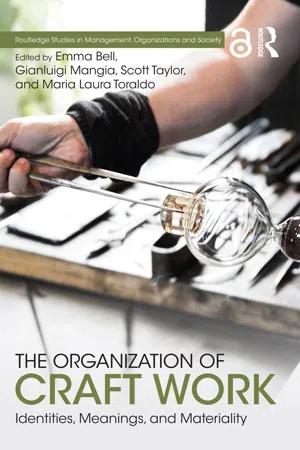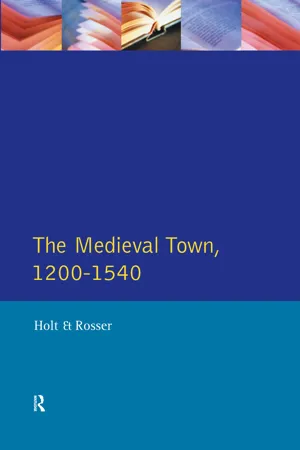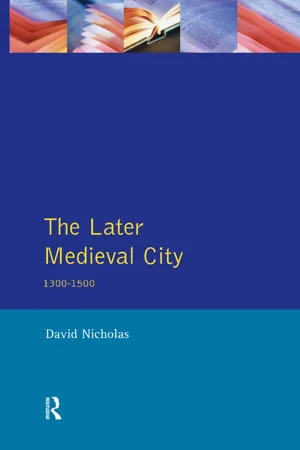History
Craft Guilds
Craft guilds were associations of skilled artisans and craftsmen in medieval Europe. They regulated the practice of their craft, set standards for quality, and provided support and protection for their members. Guilds played a significant role in the economic and social life of medieval towns, contributing to the development of trade and industry.
Written by Perlego with AI-assistance
Related key terms
8 Key excerpts on "Craft Guilds"
- eBook - ePub
The Craft of Church Planting
Exploring the Lost Wisdom of Apprenticeship
- Selvaratnam(Author)
- 2022(Publication Date)
- SCM Press(Publisher)
6A guild is a group of people who do the same work or who affiliate around a common interest. Though the spelling ‘guild’ is most used, it can also be written as ‘gild’ as it is derived from the Anglo-Saxon ‘Gildan’ meaning ‘to pay’. Gabriel La Bras suggests that ‘gild’ in the Germanic languages has the ancient meaning of ‘fraternities of young warriors practising the cult of heroes’ and is used in literature to refer to any group connected by rites, friendship and some shared financial resource.7 Anthony Black identifies the earliest documented use of the word in AD 450, where ‘gilda’ was a sacrificial meal associated with religious liberation and the cult of the dead. The common threads suggest that guilds are a group of people, often with subscription membership, who are connected in common purpose and relationship.There were four main kinds of medieval guild: religious guilds, for pious devotion and good works; frith guilds, for the promotion of peace, friendship and the establishment of law and order; merchant guilds, for trade and commerce; and Craft Guilds.8 Each craft guild focused on a specific artisan trade, such as candle making, weaving, bookbinding or printing. A large city in the Middle Ages might have as many as 100 different types of guild, each providing a means for trade and craft skills to be passed to the next generation.Craft Guilds were associations and confraternities of artisan craft workers organized in workshop small business units which were overseen by an owner-master. The earliest English Craft Guilds began in London, Oxford and York.9 The first record of a trade guild in York appears in 1163 in the Acta of Henry II , which lists the granting of the King’s confirmation of the ‘weavers’ guild and customs’ in exchange for an annual payment of ten pounds. By 1180, the same record lists guilds of glovers, saddlers, hosiers and cordwainers (shoemakers) as established bodies.10 By the thirteenth century guild training in York had become prolific: for example, in 1415 there were 96 Craft Guilds in York,11 a time in which the population of the city was no more than 15,000 people.12 - eBook - ePub
Craft Guilds in the Early Modern Low Countries
Work, Power, and Representation
- Catharina Lis, Hugo Soly, Maarten Prak(Authors)
- 2017(Publication Date)
- Routledge(Publisher)
1Map 2.1 The Low Countries in the late sixteenth centrury (divided into nine sub-regions)key: numbers to the regions in table 2.1Put another way, an analysis of the incidence of Craft Guilds (as we have defined them) in the Low Countries by subregion (see map 2.1 ) and subperiod or for a cross section of years, can provide a good basis for a further study of their specific functions later in this book. However, we will not be limiting ourselves to just a series of bare facts. We will also be endeavouring to point out similarities and differences, principally concerning the relationship between the foundation and existence of Craft Guilds on the one hand and demographic, economic and political-institutional developments on the other. One way of doing this is to track as many Craft Guilds as possible in the Low Countries from the early eleventh century until the abolition of the guilds eight hundred years later. For this purpose, datasets for Belgium and Luxembourg and for the Netherlands have been compiled and as much as possible, analysed in a consistent fashion.2. The earliest guilds
The earliest reference to an organization of fellow tradesmen in the Low Countries is almost a thousand years old and comes from Tiel, now in the Dutch province of Gelderland. According to an account written by the monk Alpertus of Metz between 1021 and 1024, an association of merchants existed in Tiel. Apart from having a social function (drinking-bouts were popular), the association also played a role in providing credit and in mediating in trade disputes.2 Soon afterwards, Tiel ceased to be a significant commercial settlement, and the association too disappeared. It is quite possible that associations of fellow tradesmen had existed even earlier in the Roman cities of the Low Countries, but they are not documented for this period — unlike those in the South and southeast of the Empire;3 nor, then, do we have any evidence regarding the possible continuity between such early associations and their later medieval counterparts. We are on firmer ground when we look at the cities founded from the eleventh century onwards. The earliest extant texts we have relate to cities in the extreme northwest of present-day France — governed at that time by the counts of Flanders and Hainault. There, associations of tradesmen developed into permanent organizations, officially recognized by the government, and whose aim it was to secure and defend a monopoly against the claims of fellow citizens and competitors from elsewhere. We know from a charter possibly drawn up around 1067 that the city of Valenciennes in Hainault had an organization of cloth merchants; a similar document dating from 1072–1083 has survived for Sint Omaars in Artois.4 Other larger urban agglomerations, almost all of which lay south of the line between Maastricht and Antwerp at that time (the main exception being Utrecht), might also have had such organizations, but no written documentation has survived.5 - eBook - ePub
- Laura Price, Harriet Hawkins(Authors)
- 2018(Publication Date)
- Routledge(Publisher)
Craft Guilds certainly have an enduring presence in the UK context: they emerged as powerful trade institutions in the early modern period; experienced a revival in association with the Arts and Crafts movement in the late 19th century; and developed in a new form as practitioner-led networks during the 20th century. One of the enduring features of the guild system is the necessary achievement of standard of skill in order to join, recognising that members are professional makers, using their craft skills to secure their livelihood. This requirement of ‘standard’ in order to join a guild was established within the medieval guild system. Medieval guilds had strict regulations of standards, offered a system for the division of labour in the market, offered a degree of care for the welfare of their members, and sought to enable the intergenerational passing on of skill and standard through the training of apprentices. Although there are debates amongst economic historians on whether these practices fostered innovation or stagnation (see Richardson, 2001; Richardson, 2004), the standard was seen as a mark of trust in the quality of a person’s work, and this ‘stamp’ of approval continues to be a powerful signifier of the guild ideal. Although the guild system was weakened by the time of the industrial revolution in the UK, the 19th century saw a revival of guild ideals through the anti-industrial critiques and the spirit of new-medievalism in the Victorian period. The 19th century socialist Arts and Crafts Movement railed against the demeaning impacts of mass production, and promoted the standards of medieval hand-skilled labour and collective workshop organisation. Such sentiments were found in the writings of John Ruskin and William Morris and through figures such as Charles R. Ashbee, a noted architect and designer of silver and jewellery. For Ashbee, ‘The Arts and Crafts movement then, if it means anything, means Standard, whether of work or of life, the protection of Standard, whether in the product or in the producer, and it means that these two things must be taken together’ (Ashbee, 1908: p.10). His reflections on standards were written in 1908 shortly after he moved his workshops called the ‘Guild of Handicrafts’ from London to Chipping Camden in rural Gloucestershire. This enterprise was ultimately to fail, but Ashbee had attempted to run his workshop with a vision of a standard that brought together the value of craft and human labour. - eBook - ePub
- Nelly Hanna(Author)
- 2014(Publication Date)
- The American University in Cairo Press(Publisher)
These questions are easier to answer in relation to merchants than in relation to artisans. The merchants of Cairo who handled the Red Sea transit trade, spices, coffee, and Indian textiles, which were sent to numerous destinations around the Mediterranean and from there farther on, were quite likely to feel the consequences of the intensified commercial activity of the period from about 1600 to 1800. They had a quasi-monopoly over the Red Sea trade, especially when the coffee coming from Yemen that they handled ultimately reached distant parts of the world, not only in the Ottoman Empire but all over Europe, where it became one of the most fashionable drinks of the seventeenth century. It is not difficult to see that merchants would feel the consequences of an expansion in world trade.When we turn from merchants and their trade to artisans and their production, the picture is less clear and studies on the subject fewer. Views on the subject are divided. For a long time, scholars considered guilds to be structures that were static, restricted in their movements by state controls. They portrayed artisans and craftsmen as incapable of change, to a certain extent because they were governed by restrictive guild rules. For many historians, the guilds were structures ‘outside history,’ functioning regardless of their regional context. Early studies on the subject tended to emphasize the stationary character of these structures. Gabriel Baer, for example, who wrote one of the first extended studies on the subject, which remained influential for some time, considered guilds to be traditional structures bringing together persons of the same craft, headed by a shaykh. The guild was recognized by the state but was strongly influenced by state controls over its activities. The guild discouraged competition between its members but at the same time offered them fair treatment. Expansion of a guild was made difficult by restrictions for entrance, as a way of protecting its members from competition; persons who were not members of a particular guild were not allowed to undertake the activities in which it specialized.1Since then, the emergence of court records as a major source for Ottoman history has given studies on guilds a great push forward. We have numerous books and articles on many aspects of guild history in the various cities of the empire, such as Cairo, Istanbul, Bursa, Damascus, and Jerusalem. As a result, we know much more about this structure than did the scholars of a generation earlier. This new scholarship shows that guilds were flexible structures; that there was enormous variety between them; that there were various models of the relationship between guild and state as well as between guild head and guild members; and that guilds could change their internal structure over time. As more studies were undertaken, it became clear that there were also differences between the artisans and guilds of one city and those of another. In Istanbul and in other Anatolian towns, for instance, the weight of the central state on guild activity was greater than it was in Cairo since, in the view of Timur Kuran, it restricted their room for maneuver and curtailed their development.2 - eBook - ePub
- Geoffrey Crossick(Author)
- 2016(Publication Date)
- Routledge(Publisher)
These were a town’s most basic institutions, bridging the private world of economic interests and the public sphere of urban government and ritual. Municipal governments saw in guilds a means to police both production standards and labour and market relations. Guild formation was encouraged in much of North-Western Europe from the fifteenth century onwards, and through the early modern period they became intermediary bodies for the regulation of prices, quality and the behaviour of apprentices and journeymen. 74 In much of Europe artisanal corporations sustained the civic as well as the social order of the town, often constituting the institutional core of urban government. They were not generally dominant – though where the urban patriciate was rooted in local mercantile activity they might maintain their corporate links – but they frequently played a significant role. In early sixteenth-century Augsburg, for example, a careful equilibrium of patrician and guild power saw the guilds overwhelmingly dominant on the Great Council, but in a more careful balance with wealthy patricians on the more influential Small Council. 75 Those may have constituted the peak years for guild masters in German urban politics for, as Friedrichs shows in his essay, artisanal representation on city councils declined during the later sixteenth and seventeenth centuries. In much of early modern Europe the right to practise a trade as a master, the rights of citizenship, and the rights of residence were closely related, especially in the German areas of Central Europe, and even within the rather different institutional setting of England until the seventeenth century a man often had to be free of the city to practise an independent economic activity - eBook - ePub
The Organization of Craft Work
Identities, Meanings, and Materiality
- Emma Bell, Gianluigi Mangia, Scott Taylor, Maria Laura Toraldo(Authors)
- 2018(Publication Date)
- Routledge(Publisher)
These two organisational case studies enabled us to collect data from a large cohort of professional designer-makers who have successfully forged their livelihood in rural areas. Understanding their motivations for joining a membership organisation, and their reasons for supporting it enabled us to learn about the professional needs of crafts practitioners in the contemporary creative economy. Paying attention to the way in which makers value their guild membership and the practices of the guild enabled us to consider what makes these organisations robust communities of practice. We should guard against over-romanticising such organisations simply because they have been sustained over long periods of time. Instead we should use them to understand how organisations might serve the needs of contemporary craft workers, and the challenges for enabling dispersed rural creative workers to gain the advantages of working together in mutually supportive ways.The original impetus to undertake this research was recognition that for several decades guild organisations had successfully served a growing membership and navigated the challenges of sustaining a grass-roots, volunteer maker-led network. Each guild had followed a slightly different path with varying degrees of professional administration but maintained their status as member-led organisations. For a sector that is dominated by sole practitioners, the organisations offered something that makers valued, and wished to invest in, year after year. The creative industries sector often overlooks the crafts, as a sector of limited economic value; however, Craft Guilds, as modes of organisational support, may in fact offer much to the wider creative economy (see also Luckman (2015: 27 and 63) for an acknowledgment of the place of Craft Guilds in the creative economy). They have shown how it is possible to sustain and improve the livelihoods of dispersed creative workers who wish to connect to their peers, gain validation, receive recognition and ensure that the outputs of their creative labour are appropriately placed in the market.Achieving Membership within a Craft Community of PracticeTo join the Gloucestershire Guild of Craftsmen or the Devon Guild of Craftsmen a maker must put forward an application including examples of their work and a written explanation of their craft practice. Both guilds have committees which meet to discuss prospective members’ work and to judge it against their collective understanding of what makes up ‘guild quality’. This takes into account the skill of the maker, their individual style and design qualities, quality of the product and attention placed on the finish of the work. A maker is expected to have a style that is recognisably theirs, not derivative, and individual elements are expected to make up a coherent portfolio of work. Both guilds accept makers who have professional standards, with Associate membership being available for those who are starting out on their career path. - eBook - ePub
- Richard Holt, Gervase Rosser(Authors)
- 2014(Publication Date)
- Routledge(Publisher)
Chapter Seven Craftsmen and the Economy of London in the Fourteenth Century 1 E. M. Vealefrom A. E. J. Hollaender and W. Kellaway (eds.), Studies in London History presented to Philip Edmund Jones (Leicester, 1969)A popular image of the craftsman in the medieval town, engaged upon his particular trade under the close supervison of a control ling gild system, is dispelled by this study of manufacturing industry in London. The prestige of the major London gilds of livery companies has distorted our perception of the economic life of the capital. In reality London, by far the largest city in England boasted an enormous variety of specialisms, many unregulated by formal gild control. Here we read of feather-mongers and seal engravers, wimplers and linen-armourers - often highly skilled men and women who were at the same time sufficiently versatile to pursue more than one craft. When by the end of the medieval period citizenship of London could be acquired only through gild membership, entailing enrolment in one of the livery companies, citizen would carry an occupational designation which frequently bore little relationship to how he actually made his living. The relationship between the craft organizations and municipal authority calls for further study. It is clear that informal craft as sociations pre-existed their legitimation and formal incorporation into city government. Arguably they continued to serve the interest of their members, while at the same time they provided the city governors with a convenient means of control. Craftswomen briefly illustrated here, are given fuller treatment in the recent work of Swanson and Goldberg, cited under Editorial suggestion for further reading on page 140.Historians interested in the economic development of fourteenth century London have tended hitherto to direct their attention towards its role as a great port and distributive centre, and their particular concern has been with mercantile activities of all sorts. But the reverse side of the coin, the role of Londoners in providing supplies and services for those attracted to the City, whether as permanent inhabitants or temporary residents, and the impact of changes in their requirements on her industrial and commercial development has been little studied. We should like to have answers, however partial and tentative they have to be, to a number of important questions. Could London craftsmen satisfy the requirements of exacting customers drawn from the City's wealthy and sophisticated society? Or were the bulk of the luxury goods acquired of foreign origin? Or were they manufactured by Londoners from materials of foreign origin? To what extent were men from the provinces, or from particular areas, whether great lay or ecclesiastical magnates or humbler traders, accustomed to turn to London craftsmen for work they required, and were there fields in which Londoners seem to have been particularly expert? What was the effect of the concentration of an increasing range of governmental activity in the capital and the size of its transient population? How important a contribution to London's economy was the need to supply the vast range of services required - food, accommodation, transport, clerical and domestic help, etc.? What changes took place during the century in London's industrial development? It was not, for instance, to be expected that the City's economy should develop during the middle years of the century unaffected by the efforts which went into the prosecution of the war with France. How important was this? I propose in this brief paper - which excludes for convenience the question of food supplies - to consider some of the preliminary problems and suggest lines for further study. - eBook - ePub
The Later Medieval City
1300-1500
- David Nicholas(Author)
- 2014(Publication Date)
- Routledge(Publisher)
55 Several criteria determined the status of trades:- The antiquity of the guild;
- Its strategic value to the survival of the community, such as through food procurement or production;
- Whether the local market was large;
- Whether the local market was captive;
- Whether the guild controlled the supply of raw materials that its craft manufactured into consumer goods;
- Whether the guild’s product could be exported outside the city;
- Whether the trade was unhygienic;
- Whether it offered access to wholesale trading or control of strategic commodities.
The rank order of the guilds in civic processions is a key to their standing. It was not invariable and combined elements of prestige with size of membership, particularly in places that were still giving corporate recognition to new trades. Direct access to the market was thus important, and guilds that sold finished products had higher rank than those whose members merely laboured. In 1392 the council of Valencia fixed the order in which the twenty-four guilds would appear during royal entries. The butchers led, followed by the silkworkers, tanners, tawyers, cutlers, drum makers, bakers, mat makers, weavers, fishmongers, smiths, millers, animal brokers, carpenters. The list ended with tailors, silversmiths (both of which were among the most prestigious trades elsewhere), curriers and cloth preparers. By 1459 there were twenty-nine recognised trades, with butchers still at the top, followed by tawyers, lacemakers, masons, manual labourers, tanners, and the others in roughly the same order except for some new trades.56
Learn about this page
Index pages curate the most relevant extracts from our library of academic textbooks. They’ve been created using an in-house natural language model (NLM), each adding context and meaning to key research topics.
